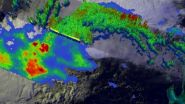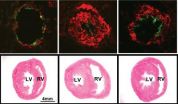(Press-News.org) VIDEO:
NASA's TRMM Satellite Sees Powerful Towering Storms in Cristobal On Aug. 26, NASA's TRMM Satellite saw a band of thunderstorms with heights of over 15km (about 9.3 miles) and was...
Click here for more information.
NASA's TRMM satellite identified areas of heavy rainfall occurring in Hurricane Cristobal as it continued strengthening on approach to Bermuda.
NASA's Tropical Rainfall Measuring Mission or TRMM satellite flew above Hurricane Cristobal on August 26 at 11:35 UTC (7:35 a.m. EDT) gathering rainfall data. A rainfall analysis derived from TRMM's Microwave Imager (TMI) and Precipitation Radar (PR) data instruments were overlaid on visible/infrared image from NOAA's GOES-East satellite to create a total picture of the storm. The image was made at NASA's Goddard Space Flight Center in Greenbelt, Maryland. NASA and the Japan Aerospace Exploration Agency manage TRMM.
When TRMM captured that rainfall data, Cristobal was a category one hurricane with sustained winds estimated to be slightly above 65 knots (about 75 mph). Cristobal didn't have a clearly defined eye because vertical wind shear was still affecting the tropical cyclone's appearance and pushing clouds and storms away from the center. TRMM PR and TMI rainfall data found heavy rain to the northeast of Cristobal's center and in intense convective storms within a feeder band streaming in from the southwest. Some of the powerful storms in the feeder band were found by TRMM PR to be dropping rain at a rate of 133.8 mm (5.2 inches) per hour.
TRMM's Precipitation Radar (PR) reflectivity data were used to create a 3-D view of precipitation within the feeder band (band of thunderstorms wrapping into the center) south of Cristobal's center. Those data showed that some energetic storms in this band were reaching heights of over 15km (about 9.3 miles) and were generating heavy rain.
Satellite imagery on August 27 showed some strong thunderstorms had redeveloped near the center of Cristobal mainly in the western semicircle. Satellite imagery also showed that dry air was wrapping south and east of the center.
At 11 a.m. EDT on Wednesday, August 27, Cristobal's maximum sustained winds were near 80 mph (130 kph) and some strengthening is possible. It was centered near latitude 31.8 north and longitude 72.2 west. That puts the center of Cristobal about 435 miles (700 km) west of Bermuda and even closer to Cape Hatteras, North Carolina at 300 miles (485 km) to the Cape's southeast.
Cristobal has a large wind field where hurricane force winds extend outward from the center up to 60 miles (95 km) and tropical storm force winds extend outward up to 205 miles (335 km). The estimated minimum central pressure is 983 millibars.
Cristobal is moving toward the north near 12 mph (19 kph) and the National Hurricane Center (NHC) expects a turn to the northeast. NHC noted that the center of Cristobal will pass well northwest of Bermuda late on August 27 and stay away from the U.S. and Canadian mainland on its track to the North Atlantic Ocean.
Cristobal is expected to become a powerful extra-tropical cyclone over the north Atlantic by Friday, August 29.
INFORMATION:
Text credit: Hal Pierce/Rob Gutro
SSAI/NASA's Goddard Space Flight Center
NASA's TRMM Satellite sees powerful towering storms in Cristobal
2014-08-27
ELSE PRESS RELEASES FROM THIS DATE:
Experiments explain why some liquids are 'fragile' and others are 'strong'
2014-08-27
Only recently has it become possible to accurately "see" the structure of a liquid. Using X-rays and a high-tech apparatus that holds liquids without a container, Kenneth Kelton, PhD, the Arthur Holly Compton Professor in Arts & Sciences at Washington University in St. Louis, was able to compare the behavior of glass-forming liquids as they approach the glass transition.
The results, published in the August 6 issue of Nature Communications, are the strongest demonstration yet that bulk properties of glass-forming liquids, such as viscosity, are linked to microscopic ...
Novel 'butterfly' molecule could build new sensors, photoenergy conversion devices
2014-08-27
TALLAHASSEE, Fla. — Exciting new work by a Florida State University research team has led to a novel molecular system that can take your temperature, emit white light, and convert photon energy directly to mechanical motions.
And, the molecule looks like a butterfly.
Biwu Ma, associate professor in the Department of Chemical and Biomedical Engineering in the FAMU-FSU College of Engineering, created the molecule in a lab about a decade ago, but has continued to discover that his creation has many other unique capabilities.
For example, the molecular butterfly can flap ...
A touching story: The ancient conversation between plants, fungi and bacteria
2014-08-27
MADISON, Wis. — The mechanical force that a single fungal cell or bacterial colony exerts on a plant cell may seem vanishingly small, but it plays a heavy role in setting up some of the most fundamental symbiotic relationships in biology. In fact, it may not be too much of a stretch to say that plants may have never moved onto land without the ability to respond to the touch of beneficial fungi, according to a new study led by Jean-Michel Ané, a professor of agronomy at the University of Wisconsin-Madison.
"Many people have studied how roots progress through the soil, ...
Protein in 'good cholesterol' may be a key to treating pulmonary hypertension
2014-08-27
Oxidized lipids are known to play a key role in inflaming blood vessels and hardening arteries, which causes diseases like atherosclerosis. A new study at UCLA demonstrates that they may also contribute to pulmonary hypertension, a serious lung disease that narrows the small blood vessels in the lungs.
Using a rodent model, the researchers showed that a peptide mimicking part of the main protein in high-density lipoprotein (HDL), the so-called "good" cholesterol, may help reduce the production of oxidized lipids in pulmonary hypertension. They also found that reducing ...
Research geared to keep women from fleeing IT profession
2014-08-27
WACO, Texas (August 27, 2014) – For years, employers and experts have been trying to reverse the exodus of women from information technology positions.
They're failing.
Studies show that women are significantly underrepresented in the IT field, and the number of women who've graduated with degrees in computer and information science have plummeted from 37 percent in 1985 to 18 percent in 2011.
The failure to "stop the bleeding" stems, in part, from the industry's reliance on an oft-cited, outdated and under-studied research model, said Cindy Riemenschneider, Ph.D., ...
No cookie-cutter divorces, so what info should online co-parenting classes offer?
2014-08-27
URBANA, Ill. – Required online classes for divorcing couples who have children are good at teaching parents how to deal with children's needs and responses to their family's new situation. But co-parenting couples would benefit from content that helps adults cope with their own emotions and from unique tracks for families with special circumstances such as intimate partner violence or alcoholism, said a University of Illinois researcher in human and community development.
"There is no cookie-cutter divorcing couple, and with online programming, educators are able to supply ...
NASA telescopes uncover early construction of giant galaxy
2014-08-27
Astronomers have for the first time caught a glimpse of the earliest stages of massive galaxy construction. The building site, dubbed "Sparky," is a dense galactic core blazing with the light of millions of newborn stars that are forming at a ferocious rate.
The discovery was made possible through combined observations from NASA's Hubble and Spitzer space telescopes, the W.M. Keck Observatory in Mauna Kea, Hawaii, and the European Space Agency's Herschel space observatory, in which NASA plays an important role.
A fully developed elliptical galaxy is a gas-deficient ...
The high cost of hot flashes: Millions in lost wages preventable
2014-08-27
The steep decline in the use of hormone therapy has spawned a prevalent but preventable side effect: millions of women suffering in silence with hot flashes, according to a study by a Yale School of Medicine researcher and colleagues.
In the study published in the Aug. 27 online issue of the journal Menopause, the team found that moderate to severe hot flashes — also called vasomotor symptoms (VMS) — are not treated in most women. Women with VMS experience more than feeling hot; other frequently occurring symptoms include fatigue, sleep disturbance, depression, anxiety, ...
NASA begins hurricane mission with Global Hawk flight to Cristobal
2014-08-27
The first of two unmanned Global Hawk aircraft landed at NASA's Wallops Flight Facility in Wallops Island, Virginia, on Aug. 27 after surveying Hurricane Cristobal for the first science flight of NASA's latest hurricane airborne mission.
NASA's airborne Hurricane and Severe Storm Sentinel, or HS3, mission returns to NASA Wallops for the third year to investigate the processes that underlie hurricane formation and intensity change in the Atlantic Ocean basin. HS3 is a collaborative effort that brings together several NASA centers with federal and university partners.
The ...
Junk food makes rats lose appetite for balanced diet
2014-08-27
A diet of junk food not only makes rats fat, but also reduces their appetite for novel foods, a preference that normally drives them to seek a balanced diet, reports a study published in the open-access journal Frontiers in Psychology.
The study helps to explain how excessive consumption of junk food can change behavior, weaken self-control and lead to overeating and obesity.
The team of researchers, led by Professor Margaret Morris, Head of Pharmacology from the School of Medical Sciences, UNSW Australia, taught young male rats to associate each of two different sound ...








